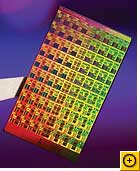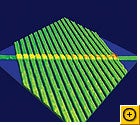
Passing The Hallway?
Network Administration
Sunday, November 14, 2010
Factors to Consider when Creating a System

Tuesday, January 5, 2010
32-Core CPUs From Intel and AMD

What is it?
With the gigahertz race largely abandoned, both AMD and Intel are trying to pack more cores onto a die in order to continue to improve processing power and aid with multitasking operations. Miniaturizing chips further will be key to fitting these cores and other components into a limited space. Intel will roll out 32-nanometer processors (down from today's 45nm chips) in 2009.
When is it coming?
Intel has been very good about sticking to its road map. A six-core CPU based on the Itanium design should be out imminently, when Intel then shifts focus to a brand-new architecture called Nehalem, to be marketed as Core i7. Core i7 will feature up to eight cores, with eight-core systems available in 2009 or 2010. (And an eight-core AMD project called Montreal is reportedly on tap for 2009.)
After that, the timeline gets fuzzy. Intel reportedly canceled a 32-core project called Keifer, slated for 2010, possibly because of its complexity (the company won't confirm this, though). That many cores requires a new way of dealing with memory; apparently you can't have 32 brains pulling out of one central pool of RAM. But we still expect cores to proliferate when the kinks are ironed out: 16 cores by 2011 or 2012 is plausible (when transistors are predicted to drop again in size to 22nm), with 32 cores by 2013 or 2014 easily within reach. Intel says "hundreds" of cores may come even farther down the line.
Memristor: A Groundbreaking New Circuit

What is it?
As its name implies, the memristor can "remember" how much current has passed through it. And by alternating the amount of current that passes through it, a memristor can also become a one-element circuit component with unique properties. Most notably, it can save its electronic state even when the current is turned off, making it a great candidate to replace today's flash memory.
Memristors will theoretically be cheaper and far faster than flash memory, and allow far greater memory densities. They could also replace RAM chips as we know them, so that, after you turn off your computer, it will remember exactly what it was doing when you turn it back on, and return to work instantly. This lowering of cost and consolidating of components may lead to affordable, solid-state computers that fit in your pocket and run many times faster than today's PCs.
Someday the memristor could spawn a whole new type of computer, thanks to its ability to remember a range of electrical states rather than the simplistic "on" and "off" states that today's digital processors recognize. By working with a dynamic range of data states in an analog mode, memristor-based computers could be capable of far more complex tasks than just shuttling ones and zeroes around.
When is it coming?
Researchers say that no real barrier prevents implementing the memristor in circuitry immediately. But it's up to the business side to push products through to commercial reality. Memristors made to replace flash memory (at a lower cost and lower power consumption) will likely appear first; HP's goal is to offer them by 2012. Beyond that, memristors will likely replace both DRAM and hard disks in the 2014-to-2016 time frame. As for memristor-based analog computers, that step may take 20-plus years.
Digital Terrestrial Televisión (DTTV or DTT)

Digital Terrestrial Television (DTTV or DTT) is the technological evolution and advance from analogue terrestrial television, which broadcasts land based (terrestrial) signals. The purpose of digital terrestrial television, similar to digital versus analogue in other platforms such as cable, satellite, telecoms, is characterised by reduced use of spectrum and more capacity than analogue, better-quality picture, and lower operating costs for broadcast and transmission after the initial upgrade costs. A terrestrial implementation of digital television technology uses aerial broadcasts to a conventional antenna (or aerial) instead of a satellite dish or cable connection.
Competing variants of digital terrestrial television technology are used around the world. Advanced Television Standards Committee ATSC is the one used in North America and South Korea, an evolution from the analogue National Television Standards Committee standard NTSC. ISDB-T is used in Japan, with a variation of it used in Brazil, Argentina, Peru, Chile[1] and most recently Venezuela, while DVB-T is the most prevalent, covering Europe, Australia, New Zealand, Colombia, Uruguay and some countries of Africa.DMB-T/H is China's own standard (including Hong Kong, though Hong Kong's cable operators use DVB); the rest of the world remains mostly undecided, many evaluating multiple standards. ISDB-T is very similar to DVB-T and can share front-end receiver and demodulator components. The United States of America has switched from Analogue to Digital terrestrial television, while Europe is hoping to have completed its switchover mostly by 2012.
Transmission
DTTV is transmitted on radio frequencies through the airwaves that are similar to standard analogue television, with the primary difference being the use of multiplex transmitters to allow reception of multiple channels on a single frequency range (such as a UHF or VHF channel).
The amount of data that can be transmitted (and therefore the number of channels) is directly affected by the modulation method of the channel.[2] The modulation method in DVB-T is COFDM with either 64 or 16 state Quadrature Amplitude Modulation (QAM). In general a 64QAM channel is capable of transmitting a greater bitrate, but is more susceptible to interference. 16 and 64QAM constellations can be combined in a single multiplex, providing a controllable degradation for more important programme streams. This is called hierarchical modulation.ref
New developments in compression have resulted in the MPEG-4/AVC standard which enable three high definition services to be coded into a 24 Mbit/s European terrestrial transmission channel.[2]
The DVB-T standard is not used for terrestrial digital television in North America. Instead, the ATSC standard calls for 8VSB modulation, which has similar characteristics to the vestigial sideband modulation used for analogue television. This provides considerably more immunity to interference, but is not immune — as DVB-T is — to multipath distortion and also does not provide for single-frequency network operation (which is in any case not relevant in the United States).
Both systems use the MPEG transport stream and H.262/MPEG-2 Part 2 video codec specified in MPEG-2; they differ significantly in how related services (such as multichannel audio, captions, and program guides) are encoded.
Advantages and disadvantages
Advantages:
- Digital reception tends to be better overall, particularly with a good signal. With a weaker signal there is little perceptible difference, in fact analogue can be better.[citation needed]
- It is easier to obtain the optimum digital picture than the optimum analogue picture.
- Many more channels can fit on the digital transmission.
- Interactive (red button) services can be provided.
Disadvantages:
- New equipment (Set-top box) may be required.
- Increased electricity consumption by the digital receiving equipment.[citation needed]
- An upgraded antenna installation may be required.
- Analogue requires lower signal strength to get a viewable picture. By extension, digital does not degrade as gracefully as analogue. For example, with low signal strength an analogue picture gets fuzzy (but is still viewable) while a digital picture freezes and stops updating.
- Switching channels is slower because of the time delays in decoding digital signals.
Reception
DTTV is received via a digital set-top box, or integrated receiving device, that decodes the signal received via a standard aerial antenna. However, due to frequency planning issues, an aerial with a different group (usually a wideband) may be required if the DTTV multiplexes lie outside the bandwidth of the originally installed aerial.[clarification needed] This is quite common in the UK, see external links.
Thursday, November 26, 2009
 "Cisco Catalyst 3750-E Series Switch"
"Cisco Catalyst 3750-E Series Switch"Deploy secure converged applications while maximizing investment protection for your evolving network and application requirements. The Cisco Catalyst 3750-E Series with StackWise Plus is an enterprise-class line of stackable wiring closet switches. Combining 10/100/1000 and Power over Ethernet (PoE) configurations with upgradeable 1 Gigabit Ethernet to 10 Gigabit Ethernet uplinks, Catalyst 3750-E switches help enhance worker productivity by enabling applications such as IP telephony, wireless, and video.
Key features include:
- Cisco EnergyWise to measure, report and reduce energy usage across the entire organization
- TwinGig converter module for migrating uplinks from 1 Gigabit Ethernet (SFP) to 10 Gigabit Ethernet (X2)
- Configurations with up to 20 watts (Class 3) of PoE on all 48 ports
- StackWise Plus for ease of use and resiliency with 128Gbps stacking
- Field replaceable and upgradable power supplies and fan tray
- Wire rate performance with 68 Gbps nonblocking switching fabric
- Multicast routing, IPv6 routing, and access control list in hardware
- Out-of-band Ethernet management port along with RS-232 console port
- Full backward compatibility with the Catalyst 3750 Series
The Cisco Catalyst 3750-E Series is orderable with two feature sets:
- The IP Base feature set includes advanced QoS, security, and basic routing functionality.
- The IP Services feature set provides a richer set of enterprise-class features, including advanced hardware-based IP unicast and multicast routing as well as Virtual Route Forwarding (VRF), and policy-based routing (PBR).
Juniper EX 3200 24T Swtich

The Juniper EX3200-24T fixed-configuration switch from Juniper Networks offer a high-performance standalone solution for access-layer deployments in branch and remote offices as well as campus networks...Featuring complete Layer 2 and Layer 3 switching capabilities, the EX3200-24T switch satisfy the wiring closet connectivity requirements of today's high-performance businesses...Featuring complete Layer 2 and Layer 3 switching capabilities, the EX3200-24T switch satisfy the wiring closet connectivity requirements of today's high-performance businesses...
Tuesday, November 24, 2009
Modular Jacks(connector)
Modular connector is the name given to a family of electrical connectors examples of which are pictured. These connectors were originally used in telephone wiring. Even though they are still used for that purpose they are used for a variety of other things as well. A modular connector's advantage over many other kinds include small size and ease of plugging and unplugging. However t he plastic retaining spring clip tends to get broken off when cables are pulled from storage for use. If that happens, the plug can easily fall out of the wall jack. Many uses that originally used a bulkier connector have migrated to modular connectors. Probably the most well known applications of modular connectors is for telephone jacks and for Ethernet jacks, which are nearly always modular connectors.
he plastic retaining spring clip tends to get broken off when cables are pulled from storage for use. If that happens, the plug can easily fall out of the wall jack. Many uses that originally used a bulkier connector have migrated to modular connectors. Probably the most well known applications of modular connectors is for telephone jacks and for Ethernet jacks, which are nearly always modular connectors.
Modular connectors were first used in the Registered Jack system, so Registered Jack specifications describe them precisely. Those are the specifications to which all practical modular connectors are built. However, the Registered Jack specifications name the wiring patterns of the jacks, not the physical connectors of either sex. Instead, these are covered by ISO standard 8877, first used in ISDN systems.